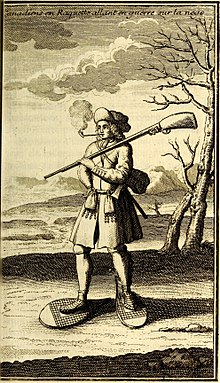| Schenectady massacre | |||||||
|---|---|---|---|---|---|---|---|
| Part of the King William's War | |||||||
 A French infantryman of the period | |||||||
| |||||||
| Belligerents | |||||||
|
Kahnawake Algonquin |
Mohawk | ||||||
| Commanders and leaders | |||||||
|
|
| ||||||
| Strength | |||||||
|
114 regulars and militia 96 Indians | 110–120 settlers and Indians | ||||||
| Casualties and losses | |||||||
| None |
60 killed 27 captured | ||||||
The Schenectady massacre was an attack against the colonial settlement of Schenectady in the English Province of New York on February 8, 1690. A raiding party of 114 French soldiers and militiamen, accompanied by 96 allied Mohawk and Algonquin warriors, attacked the unguarded community, destroying most of the homes, and killing or capturing most of its inhabitants. Sixty residents were killed, including 11 Black slaves. About 60 residents were spared, including 20 Mohawk.
Of the non-Mohawk survivors, 27 were taken captive, including five Africans. Three captives were later redeemed; another two men returned to the village after three and 11 years with the Mohawk, respectively. The remainder of the surviving captives were dragged through the snow, tied to horses, and left hungry for weeks before arriving in a Mohawk town north of Montreal. Those who survived were fed and clothed by Mohawk families and began new lives as members of the Mohawk nation.[1]
The French raid was in retaliation for the Lachine massacre, an attack by Iroquois forces on a village in New France. These skirmishes were related both to the Beaver Wars and the French struggle with the English for control of the fur trade in North America, as well as to King William's War between France and England. By this time, the French considered most of the Iroquois to be allied with the English colony of New York, and hoped to detach them while reducing English influence in North America.
- ^ Hyde, Anne F. (2022). Born of Lakes and Plains: Mixed-Descent Peoples and the Making of the American West. New York: W. W. Norton & Company. p. 23. ISBN 9780393634099.
